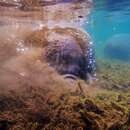mk
имиња во трошки


This species is found in the Belizean coast mangroves ecoregion (part of the larger Mesoamerican Gulf-Caribbean mangroves ecoregion), extending along the Caribbean Coast from Guatemala, and encompassing the mangrove habitat along the shores of the Bahía de Annatique; this ecoregion continues along the Belizean coast up to the border with Mexico. The Belizean coast mangroves ecoregion includes the mainland coastal fringe, but is separate from the distinct ecoregion known as the Belizean reef mangroves which are separated from the mainland. This ecoregion includes the Monterrico Reserve in Guatemala, the estuarine reaches of the Monkey River and the Placencia Peninsula. The ecoregion includes the Burdon Canal Nature Reserve in Belize City, which reach contains mangrove forests and provides habitat for a gamut of avian species and threatened crocodiles.
Pygmy or scrub mangrove forests are found in certain reaches of the Belizean mangroves. In these associations individual plants seldom surpass a height of 150 centimetres, except in circumstances where the mangroves grow on depressions filled with mangrove peat. Many of the shrub-trees are over forty years old. In these pygmy mangrove areas, nutrients appear to be limiting factors, although high salinity and high calcareous substrates may be instrumental. Chief disturbance factors are due to hurricanes and lightning strikes, both capable of causing substantial mangrove treefall. In many cases a pronounced gap is formed by lightning strikes, but such forest gaps actually engender higher sapling regrowth, due to elevated sunlight levels and slightly diminished salinity in the gaps.
Chief mangrove tree species found in this ecoregion are White Mangrove (Laguncularia racemosa), Red Mangrove (Rhizophora mangle), Black Mangrove (Avicennia germinans); the Button Mangrove (Conocarpus erectus) is a related tree associate. Red mangrove tends to occupy the more seaward niches, while Black mangrove tends to occupy the more upland niches. Other plant associates occurring in this ecoregion are Dragonsblood Tree (Pterocarpus officinalis), Guiana-chestnut (Pachira aquatica) and Golden Leatherfern (Acrostichum aureum).
In addition to hydrological stabilisation leading to overall permanence of the shallow sea bottom, the Belizean coastal zone mangrove roots and seagrass blades provides abundant nutrients and shelter for a gamut of juvenile marine organisms. A notable marine mammal found in the shallow seas offshore is the threatened West Indian Manatee (Trichecus manatus), who subsists on the rich Turtle Grass (Thalassia hemprichii) stands found on the shallow sea floor.
Wood borers are generally more damaging to the mangroves than leaf herbivores. The most damaging leaf herbivores to the mangrove foliage are Lepidoptera larvae. Other prominent herbivores present in the ecoregion include the gasteropod Littorina angulifera and the Mangrove Tree Crab, Aratus pisonii.
Many avian species from further north winter in the Belizean coast mangroves, which boast availability of freshwater inflow during the dry season. Example bird species within or visiting this ecoregion include the Yucatan Parrot (Amazona xantholora), , Yucatan Jay (Cyanocorax yucatanicus), Black Catbird (Dumetella glabrirostris) and the Great Kiskadee (Pitangus sulfuratus)
Upland fauna of the ecoregion include paca (Agouti paca), coatimundi (Nasua narica),Baird’s Tapir (Tapirus bairdii), with Black Howler Monkey (Alouatta caraya) occurring in the riverine mangroves in the Sarstoon-Temash National Park. The Mantled Howler Monkey (Alouatta palliata) can be observed along the mangrove fringes of the Monkey River mouth and other portions of this mangrove ecoregion.
Other aquatic reptiian species within the ecoregion include Morelet's Crocodile (Crocodylus moreletti), Green Turtle (Chelonia mydas), Hawksbill Sea Turtle (Eretmochelys imbricata), Loggerhead Sea Turtle (Caretta caretta), and Kemp’s Ridley (Lepidochelys kempi).
Conservation, education, and advocacy organization for manatees